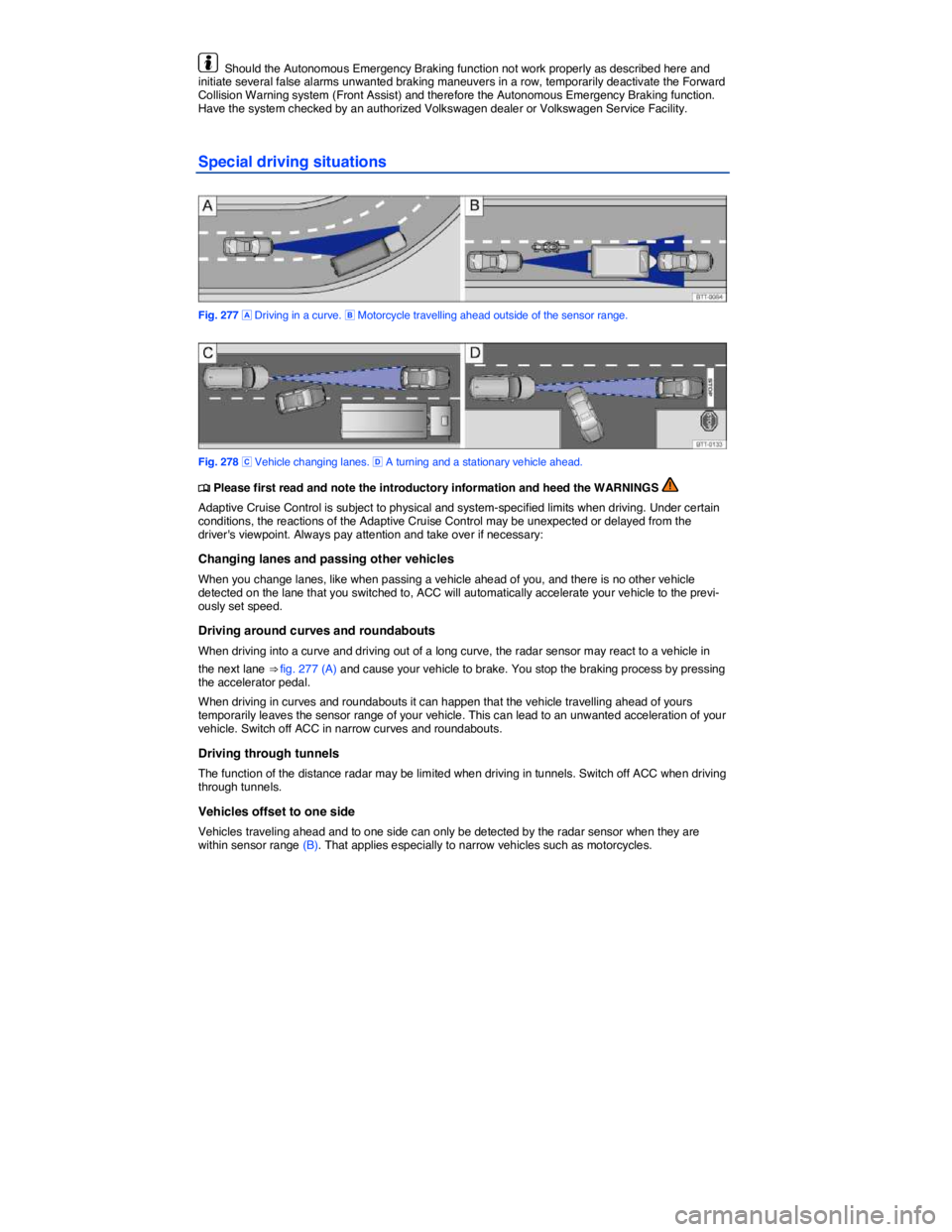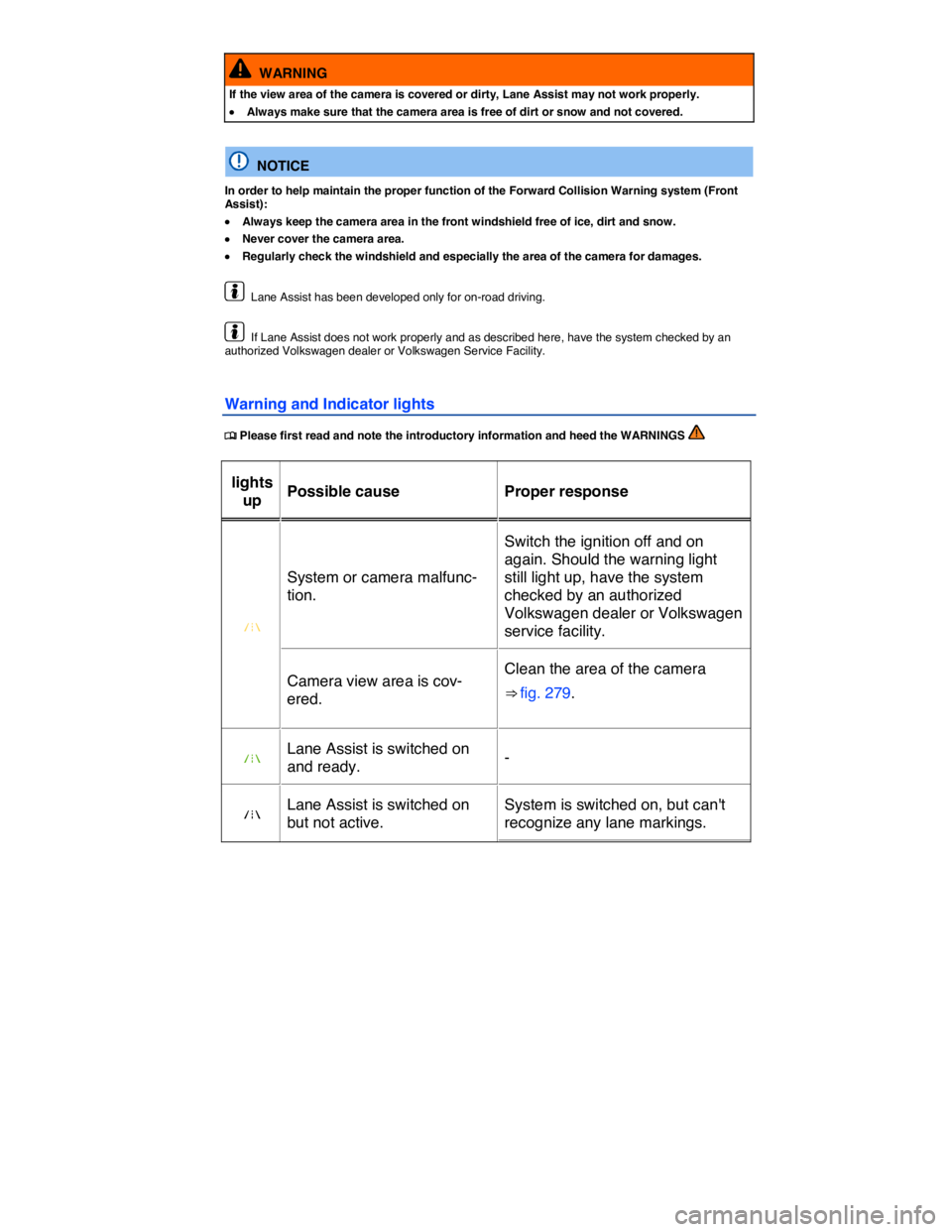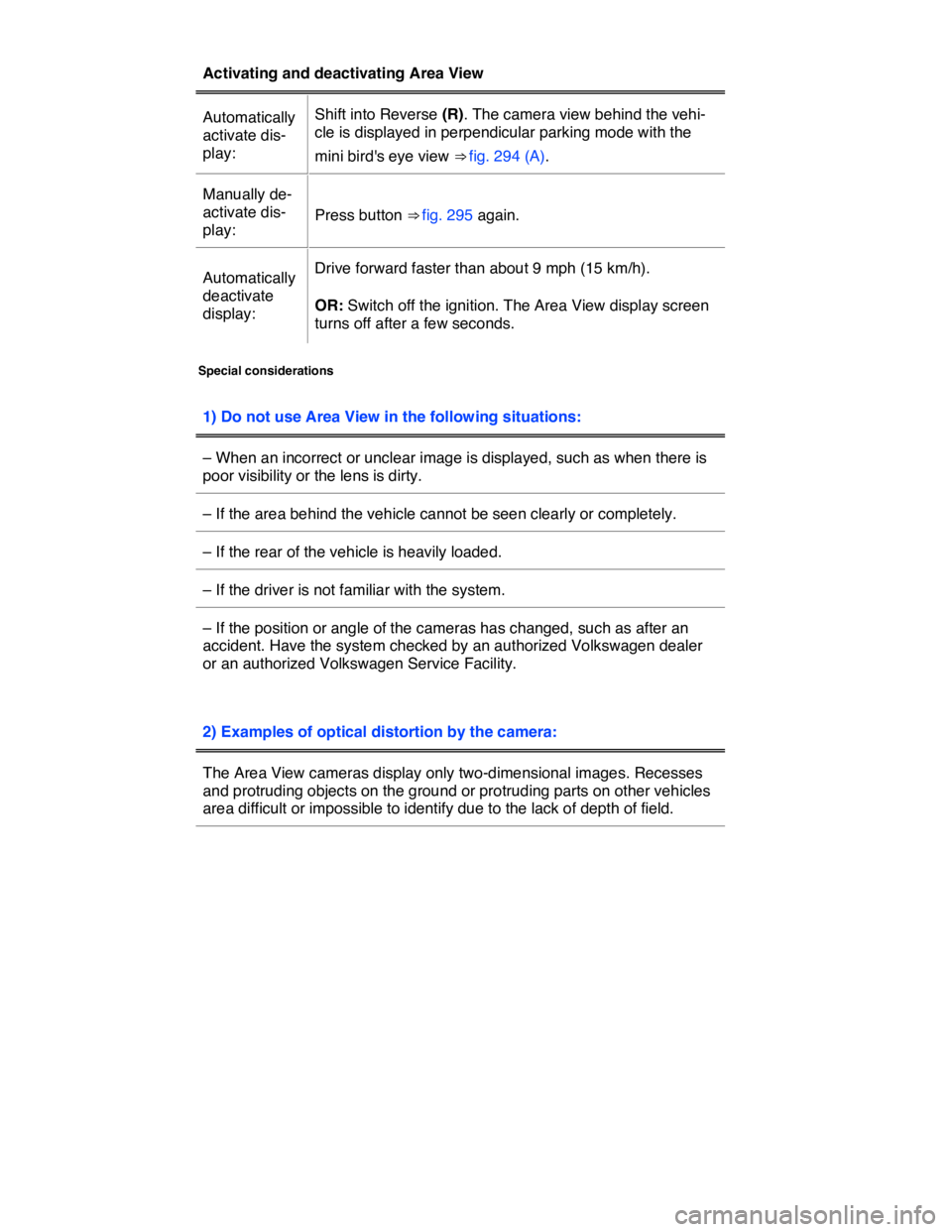2017 VOLKSWAGEN TOUAREG service
[x] Cancel search: servicePage 446 of 684

Maintenance of the high-voltage battery
Other than taking the vehicle in for scheduled maintenance to an authorized Volkswagen dealer or an authorized Volkswagen Service Facility that is qualified to do work on hybrid vehicles, there is nothing that the vehicle driver has to do to maintain the high-voltage battery.
The maintenance connection for the high-voltage battery is under the luggage compartment floor under an orange cover. This connection is only for scheduled maintenance, which must be performed only by specially trained service technicians. There is no need to remove the connector at any time
when the vehicle is being used ⇒
WARNING
The high-voltage hybrid electrical system is dangerous and can cause burns, other serious personal injuries, electrocution and death.
�x Never open, service, repair, or disconnect the high-voltage hybrid battery.
�x Never touch or let jewelry or other metal objects contact high-voltage cables or the high-voltage battery and battery poles, especially if the cables, battery, or battery poles have been damaged in a crash or in some other way.
�x Always have work on the hybrid electrical system and on systems that could be indirectly affected by it done by qualified, trained technicians, who have the know-how, experience, documentation, and tools to do the work safely.
WARNING
Failure to heed warning lights and instrument cluster text messages can cause the vehicle to break down in traffic and result in a collision and serious personal injury.
�x Never ignore warning lights or text WARNINGS.
�x Always stop the vehicle as soon as it is safe to do so.
NOTICE
�x Failure to heed warning lights or text WARNINGS can result in vehicle damage.
�x If the 12 Volt vehicle battery is disconnected or dead or has been replaced, there is a possi-bility that the combustion engine will not automatically switch off when the vehicle is powered by the electric motor. If this situation persists for several days, take the vehicle to an author-ized Volkswagen dealer or an authorized Volkswagen Service Facility that is qualified to do work on hybrid vehicles.
�x Never transport water or other liquids or fluids in open containers, such as an aquarium. If liquid is spilled in the luggage compartment, this can cause short circuits or damage the high-voltage battery.
NOTICE
Never block or cover the cooling air vents for the high-voltage hybrid battery under the rear seat. Blocking or covering these vents can damage the high-voltage battery.
Page 454 of 684

WARNING
Always remember that the Adaptive Cruise Control has limits – Using Adaptive Cruise Con-trol when it is not possible to drive safely at a constant speed can be dangerous and can lead to an accident and serious personal injury.
�x Adaptive Cruise Control will not slow the vehicle down or maintain the set distance when you drive towards an obstacle or something on or near the road that is not moving, such as vehicles stopped in a traffic jam, a stalled or disabled vehicle.
�x Always adjust your speed and the distance you keep between you and the vehicles ahead of you to the road, traffic, weather, and visibility conditions.
�x Never use Adaptive Cruise Control on steep, winding, or slippery roads (such gravel roads, wet roads, or snowy or icy roads) or on roads with standing water.
�x Never use Adaptive Cruise Control when driving in heavy or varying stop-and-go traffic.
�x Never use Adaptive Cruise Control when driving off-road or on unpaved roads.
�x Always remember that the Adaptive Cruise Control cannot detect a vehicle that is driving towards you in your traffic lane and that it cannot detect narrow vehicles such as motorcy-cles and bicycles.
�x Never follow a vehicle so closely that you cannot stop your vehicle safely. The Adaptive Cruise Control cannot slow or brake the vehicle safely when you follow another vehicle too closely. Always remember that the Adaptive Cruise Control has a braking power that is only about 30% of the vehicle's maximum braking ability, under certain circumstances the auto-matic braking function cannot bring the vehicle to a stop in time.
�x Always turn off Adaptive Cruise Control when entering turn lanes, exit lanes and construc-tion zones or in similar situations because the vehicle will automatically accelerate to the stored speed when the road ahead is clear.
�x To help prevent unintended operation of Adaptive Cruise Control, switch the system off when it is not being used.
�x It is dangerous to use the Resume feature when the previously set speed is too high for the existing road, traffic, or weather conditions.
�x When traveling downhill, the Adaptive Cruise Control may not be able to maintain a con-stant speed. The vehicle will speed up because of its own weight. Downshift and/or use the foot brake to slow the vehicle.
�x Never allow the closing speed between you and other vehicles to be so high that the Adaptive Cruise Control may not be able to slow your vehicle safely. If closing speed is too high, you must apply the brakes yourself to reduce the risk of a rear-end crash.
�x If a driver intervention warning appears in the instrument cluster display, immediately takeover the control of the brake and gas pedals and low down the vehicle or bring it to stop when necessary and according to the traffic situation.
�x If a Forward Collision Warning system (Front Assist) collision warning appears in the instrument cluster display, immediately takeover the control of the brake and gas pedals and low down the vehicle or bring it to stop when necessary and according to the traffic situation.
�x Always be prepared to takeover the control of the brake and the gas pedal in every situa-tion.
NOTICE
If you suspect that ACC and the Forward Collision Warning system (Front Assist) don't work properly or the sensors are damaged, switch off ACC immediately.
�x Go see an authorized Volkswagen dealer or Volkswagen Service Facility for assistance and have the ACC system checked.
Page 458 of 684

There are 2 radar sensors next to the fog lights on the vehicle front (3). These can detect moving vehicles up to 590 ft (180 m) in front of your vehicle.
The areas of the sensors (2) and (3) and the camera (1) must not be spray painted on or covered by stickers or other objects, since this can lead to a malfunction of the Adaptive Cruise Control (ACC) and the Front Assist system.
NOTICE
If you notice that Adaptive Cruise Control (ACC) or Front Assist doesn't work properly or the sensors are damaged, switch off ACC immediately.
�x Go see an authorized Volkswagen dealer or Volkswagen Service Facility for assistance and have the ACC system checked.
�x The sensors can be damaged or become misaligned in low speed impacts and parking maneuvers. Damaged or misaligned sensors can cause ACC or Front Assist to malfunction.
�x To help make sure that the system works properly, always keep the sensors clean, free of snow and ice; do not cover the sensors with stickers or other objects.
�x When cleaning the sensors with power washers or steam cleaners, only spray the sensors directly for a very short time, and always keep the washer nozzle at least 4 inches (10 cm) from the sensors.
�x For Declaration of Compliance to United States FCC and Industry Canada regulations
Always keep the area of the Front Assist camera clear of ice and snow.
Switching ACC on and off
Fig. 272 On the steering wheel column: Lever for Adaptive Cruise Control.
Fig. 273 Lever for Adaptive Cruise Control: Setting the distance (time intervals)
Page 468 of 684

WARNING
The Forward Collision Warning system (Front Assist) technology cannot overcome the laws of physics and system-related limits. The driver is always responsible for braking in time. If the Forward Collision Warning system issues a warning, immediately apply the brake to slow the vehicle down or avoid the obstacle, depending on the traffic situation.
�x Always adjust your speed and driving style to road, traffic, weather, and visibility condi-tions.
�x The Forward Collision Warning system cannot prevent accidents and serious injuries on its own.
�x The Forward Collision Warning system can issue unnecessary warnings in certain com-plex driving situations, for example, at traffic islands.
�x The Forward Collision Warning system can issue unnecessary warnings when its function is impaired, for example, if the radar sensor is dirty or if the position of the radar sensor has been changed.
�x The Forward Collision Warning system does not react to people, animals, or vehicles crossing or approaching in the same lane.
�x Always be prepared to take full control of the vehicle at all times.
NOTICE
If you notice that the Forward Collision Warning system (Front Assist) doesn't work properly or the sensors are damaged, switch off the Forward Collision Warning system (Front Assist) immediately.
�x Go see an authorized Volkswagen dealer or Volkswagen Service Facility for assistance and have the Forward Collision Warning system (Front Assist) checked.
If the Forward Collision Warning system (Front Assist) initiates a braking maneuver, the hydraulic braking system is under pressure. In this case the braking pedal will feel “harder” and the brake pedal travel will be shorter.
Automatic braking maneuvers can be interrupted by depressing the gas pedal or moving the steering wheel.
Deactivate the Forward Collision Warning system if it does not work as described in this chapter, for example, if multiple unwanted warnings occur. Have the system checked by an authorized Volkswagen dealer or authorized Volkswagen Service Facility.
Temporarily switch off the Forward Collision Warning system (Front
Assist) in the following situations
�
Page 471 of 684

The Autonomous Emergency Braking function should be deactivated by switching off the Forward Collision Warning system (Front Assist) in following situations:
�x When the vehicle is being towed.
�x When the vehicle is on a roller test stand.
�x When the vehicle is off road, like on construction sites or on race tracks.
�x When one of the sensors is defect.
�x When the sensors have been damaged, like after a frontal collision accident.
�x After several false alarms in a row.
�x If the sensors are covered by additional parts, like auxiliary headlights.
�x If the vehicle is driving on steep terrain or on or across slopes.
WARNING
Always remember that the Autonomous Emergency Braking function has limits – it will not release you from the responsibility to control and slow down your vehicle.
�x The Autonomous Emergency Braking function alone cannot avoid accidents and fatal injuries.
�x Under certain circumstances and complex traffic situations the Autonomous Emergency Braking function can perform unwanted braking maneuvers, like in construction sites.
�x Soiled or misaligned radar sensors can lead to unwanted braking maneuvers
�x The Autonomous Emergency Braking function does not react to people, animals, crossing traffic or vehicles that are approaching you on the same lane.
�x Always adjust your speed and the distance you keep between you and the vehicles ahead of you to the road, traffic, weather, and visibility conditions.
�x Never follow a vehicle so closely that you cannot stop your vehicle safely, under certain circumstances the automatic braking function cannot bring the vehicle to a stop in time.
�x Never allow the closing speed between you and other vehicles to be so high that the Au-tonomous Emergency Braking function may not be able to slow your vehicle safely. If closing speed is too high, you must apply the brakes yourself to reduce the risk of a rear-end crash.
�x Always be prepared to takeover the control of the brake and the gas pedal in every situa-tion.
NOTICE
If you notice that the Autonomous Emergency Braking function doesn't work properly or the sensors are damaged, switch off the Forward Collision Warning system (Front Assist) and therefore the Autonomous Emergency Braking function immediately.
�x Go see an authorized Volkswagen dealer or Volkswagen Service Facility for assistance and have the system checked.
If the Autonomous Emergency Braking function initiates a braking maneuver, the hydraulic brak-ing system is under pressure. In this case the braking pedal will feel “harder” and the brake pedal travel will be shorter.
Automatic braking maneuvers can be interrupted by depressing the gas pedal or moving the steering wheel.
The Autonomous Emergency Braking function can slow your vehicle down to a standstill, but not hold your vehicle permanently. When necessary, apply the vehicle brakes!
Page 472 of 684

Should the Autonomous Emergency Braking function not work properly as described here and initiate several false alarms unwanted braking maneuvers in a row, temporarily deactivate the Forward Collision Warning system (Front Assist) and therefore the Autonomous Emergency Braking function. Have the system checked by an authorized Volkswagen dealer or Volkswagen Service Facility.
Special driving situations
Fig. 277 �
Page 477 of 684

WARNING
If the view area of the camera is covered or dirty, Lane Assist may not work properly.
�x Always make sure that the camera area is free of dirt or snow and not covered.
NOTICE
In order to help maintain the proper function of the Forward Collision Warning system (Front Assist):
�x Always keep the camera area in the front windshield free of ice, dirt and snow.
�x Never cover the camera area.
�x Regularly check the windshield and especially the area of the camera for damages.
Lane Assist has been developed only for on-road driving.
If Lane Assist does not work properly and as described here, have the system checked by an authorized Volkswagen dealer or Volkswagen Service Facility.
Warning and Indicator lights
�
Page 499 of 684

Activating and deactivating Area View
Automatically
activate dis-
play:
Shift into Reverse (R). The camera view behind the vehi-
cle is displayed in perpendicular parking mode with the
mini bird's eye view ⇒ fig. 294 (A).
Manually de-
activate dis-
play: Press button ⇒ fig. 295 again.
Automatically
deactivate
display:
Drive forward faster than about 9 mph (15 km/h).
OR: Switch off the ignition. The Area View display screen
turns off after a few seconds.
Special considerations
1) Do not use Area View in the following situations:
– When an incorrect or unclear image is displayed, such as when there is
poor visibility or the lens is dirty.
– If the area behind the vehicle cannot be seen clearly or completely.
– If the rear of the vehicle is heavily loaded.
– If the driver is not familiar with the system.
– If the position or angle of the cameras has changed, such as after an
accident. Have the system checked by an authorized Volkswagen dealer
or an authorized Volkswagen Service Facility.
2) Examples of optical distortion by the camera:
The Area View cameras display only two-dimensional images. Recesses
and protruding objects on the ground or protruding parts on other vehicles
area difficult or impossible to identify due to the lack of depth of field.